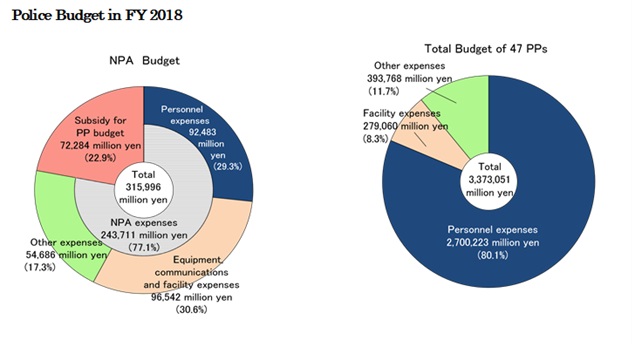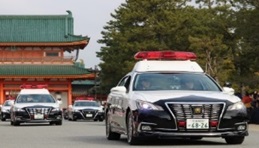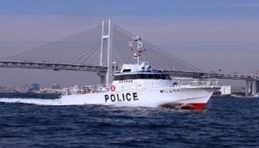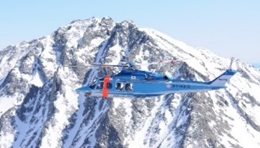National Police Agency
Organizational Structure and Authority
The Commissioner General, leading the NPA, is appointed by the National Public Safety Commission with the approval of the Prime Minister. The Commissioner General, under the supervision of the Commission, oversees the agency's operations, appoints agency employees, and manages prefectural police organizations. The NPA, as a national agency, formulates police systems and also conducts police operations regarding cases involving national public safety, undertakes administration of matters which form the foundation of police activities such as police education and training, police communications, and criminal identification as well as coordination of police administration.
Budget

※ Includes Special Account for Reconstruction from the
Great East Japan Earthquake : 1,646 million yen
The police budget consists of a national budget and prefectural budgets.
The national government covers expenses to operate the NPA, directly appropriated expenses for Prefectural Police (PP) activities of national significance, and subsidies to supplement PP budgets.
Each prefectural government pays all expenses to operate its PP, excluding the direct appropriation from the national treasury. However, with the exception of some personnel expenses for Superintendents and lower ranking officers including installation costs, the PP budget can be supplemented by subsidies from the national government.
A. Direct Appropriation from the National Treasury
The following are the major expenses directly appropriated by the national government for use by the PP:
The national government covers expenses to operate the NPA, directly appropriated expenses for Prefectural Police (PP) activities of national significance, and subsidies to supplement PP budgets.
Each prefectural government pays all expenses to operate its PP, excluding the direct appropriation from the national treasury. However, with the exception of some personnel expenses for Superintendents and lower ranking officers including installation costs, the PP budget can be supplemented by subsidies from the national government.
A. Direct Appropriation from the National Treasury
The following are the major expenses directly appropriated by the national government for use by the PP:
- Salaries and some allowances for Assistant Commissioners and above ranking officers;
- Expenses for police school training, including maintenance and management of training facilities;
- Expenses for the maintenance and management of police communications and telephone charges for police telephone lines;
- Expenses for the purchase of police equipment such as police vehicles, boats and helicopters.
B. Appropriation by Prefectural Government
Prefectural governments appropriate funds for the following use by the PP except for the expenses listed in A:
Prefectural governments appropriate funds for the following use by the PP except for the expenses listed in A:
- Salaries and allowances for Superintendents and lower ranking officers, as well as other personnel expenses including uniforms;
- Expenses for police facilities;
- Expenses for PP activities such as crime prevention, criminal investigation and traffic enforcement.
Equipment
A. Police Vehicles
Police vehicles, as the core of the mobile police force, take on the task of responding to daily occurrences of crimes and accidents. They are also used for street patrols and other police activities.
Approximately 42,500 police vehicles are equipped at police stations, police boxes (Koban), and residential police boxes (Chuzaisho) throughout the country.

B. Police Boats
As the mobile police force on the water, police boats are employed at major ports, remote islands, lakes, and marshes to patrol and fight against illegal immigration, smuggling, and poaching. Ranging from 5 to 23 meters in length, there are approximately 150 police boats nationwide.

C. Police Helicopters
As the mobile police force in the air, police helicopters are used extensively for traffic control surveillance, pursuit of suspects, rescue, and disaster relief. A total of approximately 80 small and medium-sized helicopters are operated nationwide.

Police vehicles, as the core of the mobile police force, take on the task of responding to daily occurrences of crimes and accidents. They are also used for street patrols and other police activities.
Approximately 42,500 police vehicles are equipped at police stations, police boxes (Koban), and residential police boxes (Chuzaisho) throughout the country.

B. Police Boats
As the mobile police force on the water, police boats are employed at major ports, remote islands, lakes, and marshes to patrol and fight against illegal immigration, smuggling, and poaching. Ranging from 5 to 23 meters in length, there are approximately 150 police boats nationwide.

C. Police Helicopters
As the mobile police force in the air, police helicopters are used extensively for traffic control surveillance, pursuit of suspects, rescue, and disaster relief. A total of approximately 80 small and medium-sized helicopters are operated nationwide.
